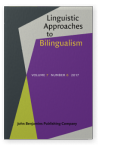Commentary published In:
Epistemological issue with keynote article “The relevance of first language attrition to theories of bilingual development” by Monika S. Schmid and Barbara Köpke[Linguistic Approaches to Bilingualism 7:6] 2017
► pp. 686–690
